Got some leftover ricotta that you want to preserve for later? Can you freeze ricotta cheese?
Or perhaps you’re wondering if you can make a ricotta-based pasta filling in advance and freeze it until ready to use.
The good news is that ricotta cheese freezes quite well, at least compared to some other dairy products. But, same as cream cheese, it separates and dries out a bit after freezing.
Because of that, defrosted ricotta works much better in certain settings than in others.
Want to learn about freezing, defrosting, and using ricotta cheese and ricotta-based mixtures?
Let’s jump right in.
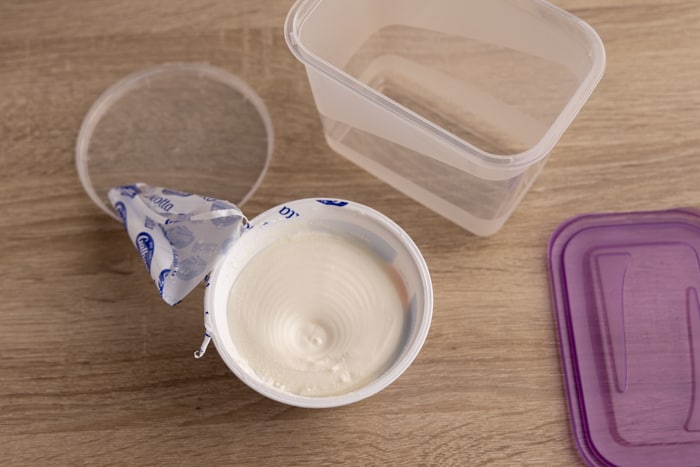
Can You Freeze Ricotta Cheese?
You can freeze ricotta cheese, but know that there will be visible separation after thawing. That texture change won’t be that bad, though, and such ricotta is still okay to use in most cooked dishes.
That said, the best options for frozen and thawed ricotta are dishes that you cook or bake, like pancakes and pasta fillings. I talk about specific examples later in the article.
Now, you’d probably want to see what thawed ricotta looks like. Here’s mine after defrosting:
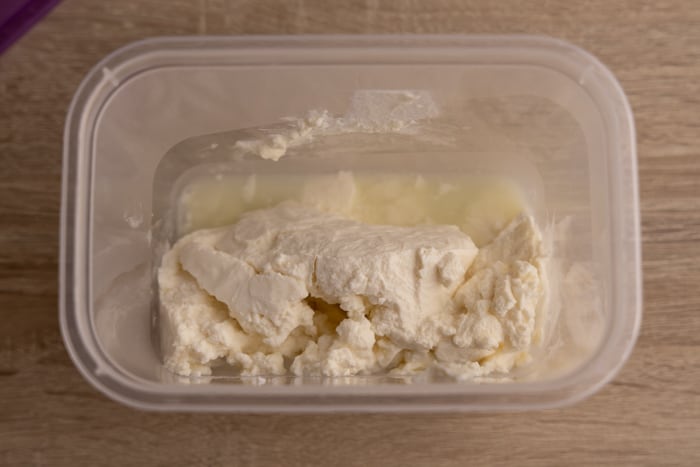
You can see that some of the whey separated from the curds, but it’s not that bad.
(Defrosted sour cream, for instance, looks much worse, but thawed feta cheese looks even better if you discard the brine before freezing.)
And that ricotta starts to look quite alright after removing the whey and stirring the rest:
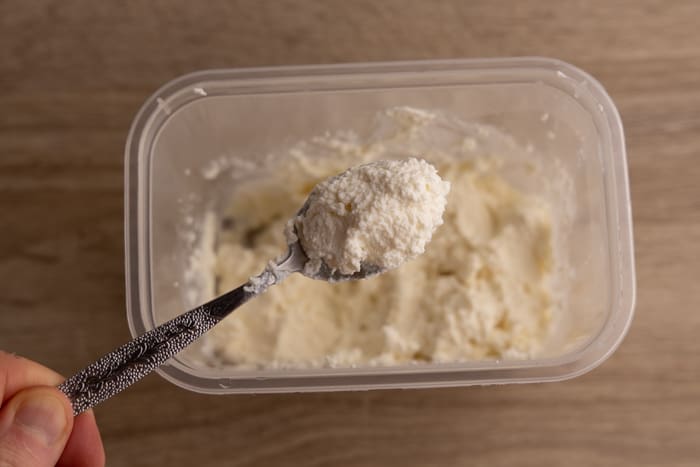
Okay, you’re probably convinced that defrosted ricotta isn’t as bad as some people paint it. It’s a bit drier than it was, even if you stir in the whey, but that’s about it.
But, say you want to prep in advance the ricotta-based mixture for your next past dish and freeze it. Can you do that?
Ricotta Cheese Mixture (or Filling)
There are a few popular ricotta cheese mixtures out there, such as:
- ricotta cheese with eggs
- classic ricotta cheese mixture (with shredded mozzarella, eggs, and spices)
- ricotta and spinach (something like this)
- anything else that’s similar to the above
Those mixtures are used for all sorts of pasta dishes like lasagna, ravioli, ziti, manicotti, and the like.
Most of them include, besides the ricotta, of course, shredded cheese (e.g., mozzarella, parmesan, or Grana Padano) and eggs. And most of them freeze quite well.
I know you might be skeptical about freezing ricotta with eggs because eggs don’t freeze particularly well.
But, freezing isn’t an issue anymore if the eggs are stirred together with other ingredients (pancake batter is a good example). They actually help bind everything together.
Now, I’m far from saying that all ricotta mixtures freeze great. But most of them should freeze well and turn out perfectly fine after cooking or baking them with pasta.
The easiest way to test yours is by prepping the mixture the day before you need it and freezing a small amount overnight. Then, the next day you defrost it, assess its quality, and use it.
One such try, and you will know for sure if your mixture freezes well.
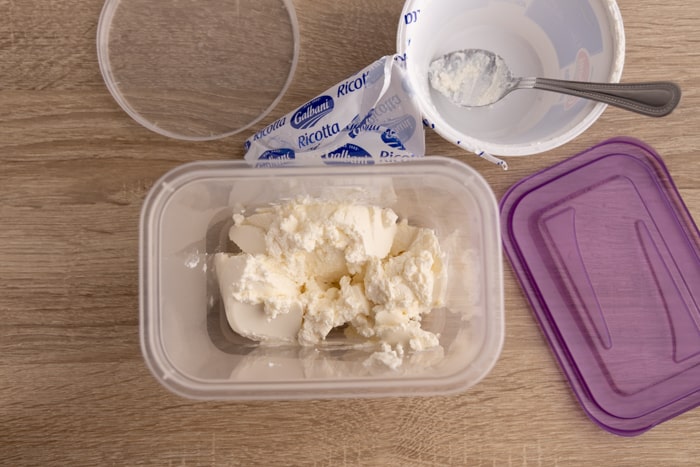
How To Freeze Ricotta Cheese
Freezing ricotta is super simple. Grab a couple of freezer-friendly containers, and let’s get to work.
Here’s how you freeze ricotta:
- Decide how you’re going to use the ricotta after thawing. It’s best to freeze the cheese in dish-sized portions to avoid any leftovers after using it. You need to decide on a recipe you’re going to use the cheese in for that to happen.
- (Optional) Remove excess whey if there is a lot on the surface. Some separation in ricotta is perfectly normal and nothing to worry about. But that whey will freeze straight into ice crystals and end up as liquid on top after defrosting. You might as well remove it using a teaspoon or paper towels before freezing.
- Portion the cheese. Grab as many containers as you need, and transfer the ricotta into them. Grab a teaspoon and level out the surface in each container. I noticed the more surface area there is, the more liquid separates during thawing, hence the suggestion.
- Freeze everything. If your containers aren’t transparent or you have lots of dairy in the freezer, consider labeling each container with the name, date, and amount. If you’re not freezing dairy products too often, it’s not necessary. I usually don’t do it.
That’s it. The same process works for both store-bought and homemade ricotta.
You can freeze an unopened container of ricotta cheese if the amount is just right for your recipe. No need to open the container just to transfer its contents into another one.
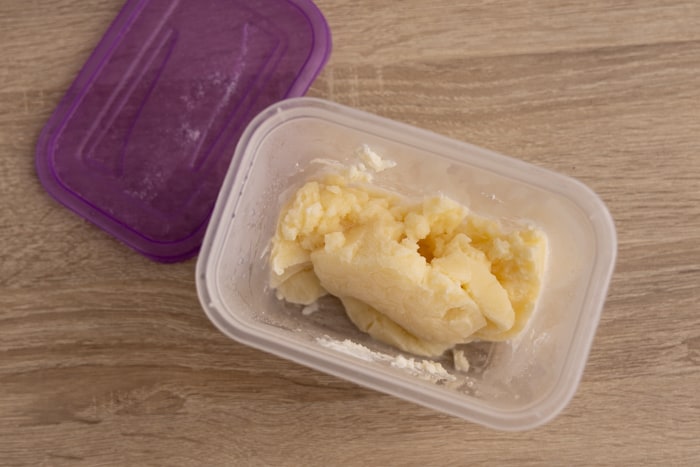
How Long Can You Freeze Ricotta?
Try to use frozen ricotta within 2 to 3 months from the day you froze it. The sooner you do that, the better the quality.
Of course, there isn’t anything special about the 3-month mark, and the ricotta won’t be much worse if it sits in the freezer for an extra week or month. It’s more of a reminder that freezing it for months on end isn’t a good idea.
I find that the longer food sits in my freezer, the less likely I’m to defrost and use it. That, of course, results in a constantly overflowing freezer.
Food that I froze recently is still top of mind, and that’s when I’m most likely to use it. But if it’s there for more than, say, 3 to 4 weeks, it often gets forgotten. That’s another reason why I advocate using frozen foods as soon as possible.
Next up, let’s talk about thawing ricotta.
How to Thaw Frozen Ricotta Cheese
To thaw ricotta cheese, transfer the container to the fridge and leave it there overnight. Those 6 to 8 hours are usually enough for the cheese to defrost.
Generally, ricotta cheese needs 4 to 8 hours to defrost, depending on the amount. You can speed things up a bit (down to about 3 to 6 hours) by submerging the container in lukewarm water (still in the fridge). Water transfers heat faster, hence the shorter thawing time.
Here’s the setup:
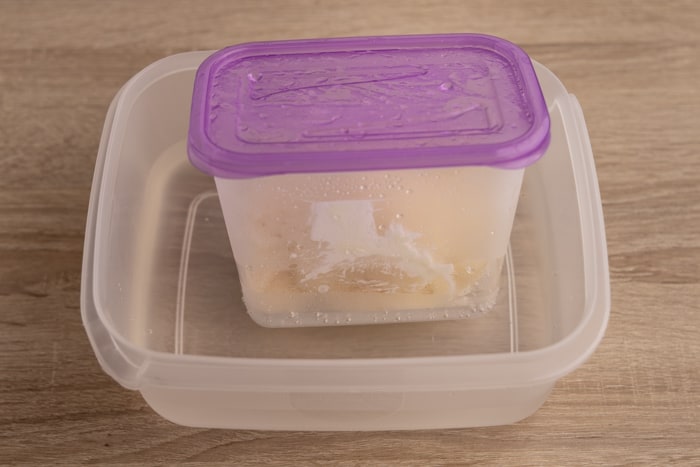
If you want to help ricotta thaw faster, grab a teaspoon and stir it after an hour or two of sitting in the fridge.
The sides will be thawed by this time, but the central area won’t. That stir will mix the frozen and defrosted areas and spread them more evenly, resulting in faster thawing.
Once your ricotta is thawed (or before you stir it during thawing), you’ll probably notice some separated liquid (as you can see in my photo above). It’s up to you whether you stir it in or discard it. I usually opt for the latter.
Last but not least, remember that defrosting ricotta at room temperature is a bad idea.
Refreezing
One great benefit of defrosting ricotta in the fridge is that you can safely refreeze it. That means that even if you freeze the cheese in portions that don’t quite match your recipe, you can still refreeze the leftovers.
That is, if you don’t have any other way to use your leftover ricotta cheese.
Nevertheless, each subsequent freezing will make the cheese drier and degrade its quality even further. Because of that, it’s better to plan out how you’re going to use the ricotta after thawing and portion it accordingly.
Long story short, you can refreeze ricotta if you thaw it in the fridge, but try to avoid it if you can.
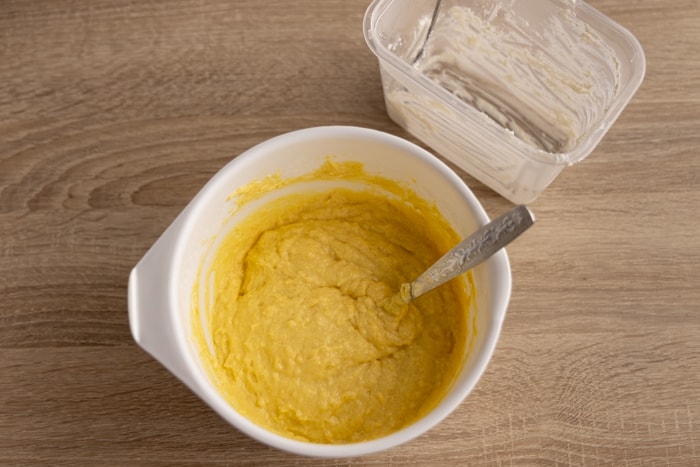
Using Thawed Ricotta
There are hundreds of dishes in which defrosted ricotta works as well as fresh ricotta does. If a dish includes cooking or baking the cheese, chances are thawed ricotta will do fine.
Some of the most popular ones include:
- pancakes
- pasta fillings – think lasagna, ravioli, or ziti filling
- cheesecakes (except maybe those no-bake ones) and similar cakes
- casseroles
- pizza, calzone
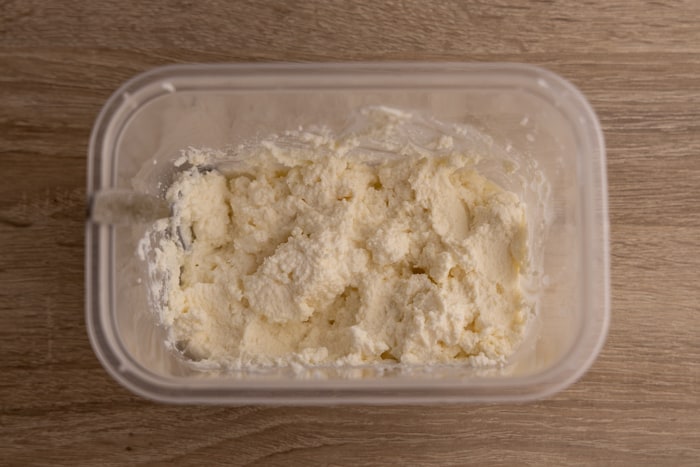
Tips
Use ricotta in a recipe you know well. If you know its ins and outs, substituting defrosted ricotta for fresh one is no biggie.
One thing to pay attention to is the texture. Thawed ricotta is drier (especially if you remove the separated whey) than its fresh counterpart, and you might need to adjust for that by adding more liquid (say milk or water).
Another thing to remember is that you don’t always need to replace the whole amount of fresh ricotta with one that’s defrosted. You can mix both in whatever proportions work for you and use that mix instead.
Say your recipe requires two containers of ricotta, but you only have one in the freezer. Great. Thaw the frozen container, grab a fresh one from the fridge and mix them.
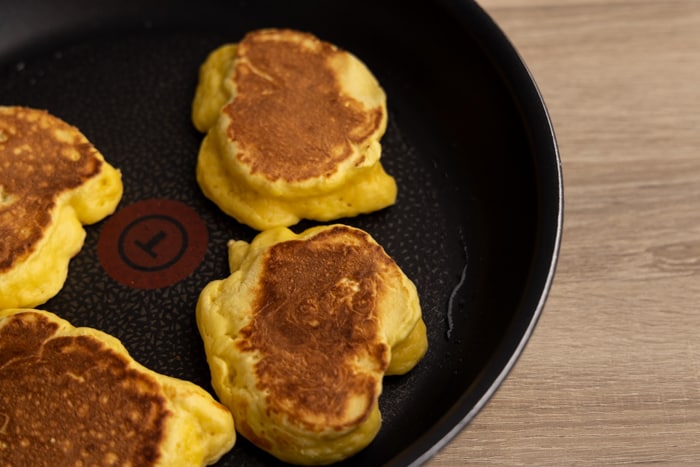
Freezing Dishes That Include Ricotta
Instead of freezing ricotta cheese by itself, in most cases, you can use it in a dish and freeze that dish instead.
I don’t know about you, but I much prefer to grab a portion of frozen lasagna from my freezer than to take a container of ricotta, defrost it, and only then cook the lasagna.
If your frozen ingredients tend to sit in the freezer forever because you never feel like defrosting and cooking something, freezing ready-to-eat dishes might be the solution for you.

A few dishes that freeze well include:
- lasagna with ricotta (here’s an article on freezing lasagna)
- ricotta cheesecakes (like this one)
- pancakes (most of them freeze well, but you can also freeze pancake batter)
- casseroles (remember to check the instructions to learn if that particular one freezes well)